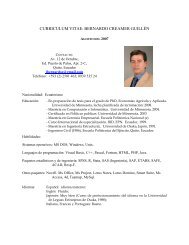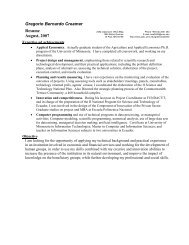Safety Culture Presentation - University of Minnesota
Safety Culture Presentation - University of Minnesota
Safety Culture Presentation - University of Minnesota
Create successful ePaper yourself
Turn your PDF publications into a flip-book with our unique Google optimized e-Paper software.
Overview <strong>of</strong> <strong>University</strong> <strong>of</strong> <strong>Minnesota</strong>‐<br />
DuPont program with Local Cooperatives<br />
Oklahoma Agricultural Cooperative Council<br />
CEO and Board Retreat<br />
July 2012<br />
Michael Boland<br />
<strong>University</strong> <strong>of</strong> <strong>Minnesota</strong><br />
Background<br />
• CEP Roundtable sponsored by CoBank (lender to<br />
cooperatives), Kansas State <strong>University</strong> and<br />
<strong>University</strong> <strong>of</strong> <strong>Minnesota</strong> had a ½ day safety<br />
culture education program in March 2011<br />
– Used speakers from DuPont and Garden City<br />
Cooperative<br />
• Program planning committee recommended DuPont<br />
– A number <strong>of</strong> firms wanted to know more about<br />
DuPont’s program<br />
– Group was formed through <strong>University</strong> <strong>of</strong> <strong>Minnesota</strong> to<br />
contract with DuPont<br />
Background on DuPont’s Program<br />
• DuPont has developed a very effective method to assess a<br />
firm’s safety culture. DuPont has found that safety culture is<br />
highly correlated to safety performance measured by<br />
reportable safety incidents.<br />
• Uses a unique culture scoring system that scores firms on a<br />
100 point scale and categorizes firms using a “Bradley<br />
Curve” relationship that cross‐classifies safety culture with<br />
reportable incidents.<br />
• The classification system uses four categories <strong>of</strong> culture:<br />
Reactive (0‐40), Dependent (40 to 60), Independent (60 to<br />
80), and Benchmark Best (“World Class” or greater than<br />
80). These scores are derived from a 24 question survey<br />
which measures three variables <strong>of</strong> culture strength:<br />
leadership, structure, and process and actions.<br />
Objective<br />
• Develop and implement a two‐year safety culture<br />
education program for agricultural cooperatives<br />
built upon the implications found from the June<br />
2011 assessment.<br />
• At the conclusion <strong>of</strong> the program, the same<br />
assessment will be done to note any<br />
improvement.<br />
• Understand the literature on ‘why people do not<br />
wear seatbelts even though they save lives’ and<br />
why one’s attitudes towards risk may change<br />
daily depending upon various circumstances
Initial June 2011 Assessment<br />
• Seven cooperatives participated<br />
(approximately 2,500 employees)<br />
• Results indicated a great deal <strong>of</strong> room for<br />
improvement<br />
• Another cohort <strong>of</strong> four conducted a similar<br />
assessment in December 2011<br />
– Results suggest room for improvement<br />
2012‐2013 Education Program<br />
• 2012<br />
• January – Managing <strong>Safety</strong>: Systems that Work for Operations Managers<br />
• February – Managing <strong>Safety</strong>: Techniques that Work for Line Supervisors<br />
• March –One‐half day Executive Leadership Workshop<br />
• August –Incident Investigation and Felt Leadership Workshop (<br />
• November –<strong>Safety</strong> Scorecard and Dashboard Development.<br />
• 2013<br />
• January ‐ Webinar to share safety scorecards and discuss process issues.<br />
• March –webinar on preparation for June reassessment<br />
• June ‐ Launch <strong>of</strong> reassessment<br />
• August – discussion <strong>of</strong> assessment results<br />
• Coordination through <strong>University</strong> <strong>of</strong> <strong>Minnesota</strong><br />
What have we learned (so far)<br />
• Need to decide on what your absolutes are with regard<br />
to safety and what that means for your culture.<br />
– Cell Phone example –a number <strong>of</strong> large firms (including<br />
DuPont have a no cell phones, including hands‐free, policy)<br />
• No cell phones – enforcement?<br />
– Parts <strong>of</strong> organization only (truck drivers)<br />
– What about letting people pull over the road to take a call?<br />
• Hands‐free –do you equip all employees with same phones and<br />
install same hands‐free technology on every vehicle?<br />
– Research says this gives people false sense <strong>of</strong> security<br />
• Ignore it; member‐farmers and employees want immediate access<br />
to employees. Agriculture is unique<br />
What have we learned (so far)<br />
• Employee backgrounds differ widely.<br />
– There is no single source <strong>of</strong> talent for safety directors<br />
in staff positions<br />
– Backgrounds vary widely<br />
• Going to market means ‘stealing from someone else’ (not<br />
healthy for entire system) or doing extensive training <strong>of</strong> new<br />
employee<br />
– Turnover is irregular<br />
• Little or no “bench strength” in organization<br />
– No common peer network (may know safety<br />
coordinator in company next to you but lack <strong>of</strong> a<br />
shared group or network)
What have we learned (so far)<br />
• Need to ensure that a senior line manager or<br />
several senior managers (who reports to General<br />
Manager or CEO) has safety management in their<br />
job responsibilities.<br />
– Staff people (especially new or junior employees) lack<br />
credibility with long‐term supervisors and managers<br />
– Staff people with safety in job title should report to<br />
this senior line manager<br />
• Move the job <strong>of</strong> safety manager to more <strong>of</strong> an education or<br />
consultant leader as opposed to a “traffic cop”<br />
What have we learned (so far)<br />
• Lots <strong>of</strong> room for improvement. Why?<br />
– Mergers, consolidation, restructuring<br />
• <strong>Safety</strong> culture not always considered in such changes<br />
– More to come; when change happens in<br />
organizations, do not neglect the change in safety<br />
cultures.<br />
• Clear from data that different organizations can have<br />
different cultures and this must be accounted for when<br />
merging or restructuring.<br />
– Employee comments are very revealing when they are<br />
allowed to ‘talk’ in an assessment.<br />
• Lack <strong>of</strong> linkage between safety and compliance education<br />
and overall culture.<br />
What have we learned (so far)<br />
• <strong>Safety</strong> committee structure is important<br />
– Need to have a safety committee (many do not)<br />
– Should be composed as a leadership committee<br />
with policy and implementation responsibilities<br />
• Compliance is an input to the committee<br />
– Needs to be chaired by CEO / General Manager<br />
• Direct reports should be part <strong>of</strong> committee structure<br />
What have we learned (so far)<br />
• <strong>Safety</strong> observations should be done<br />
– Many co‐ops do not do this yet<br />
– Policy and procedures for it should be described<br />
and implemented at every location by those with<br />
management responsibilities<br />
– Focus should be on education and learning and<br />
not on ‘gotcha’ issues.
What have we learned (so far)<br />
Questions?<br />
• No one wants a culture <strong>of</strong> fear or intimidation<br />
– Unclear whether one ‘fires’ an employee to make a<br />
statement is effective or not<br />
• Some employees want examples made and others want<br />
change to be practical<br />
• But a pattern <strong>of</strong> behavior that ignores safety must be<br />
addressed for employee morale and culture.<br />
• Literature says one needs to appeal to long‐term<br />
employees sense <strong>of</strong> legacy, realization that future<br />
is different than the past, altruisim, and<br />
leadership for next generation <strong>of</strong> employees.<br />
DRAFT VERSION 4 December 2011



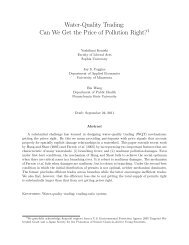
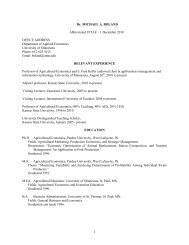


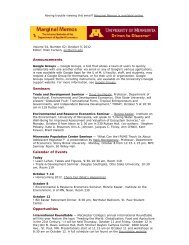

![Publications Since 2000[1].docx](https://img.yumpu.com/30237513/1/190x245/publications-since-20001docx.jpg?quality=85)

